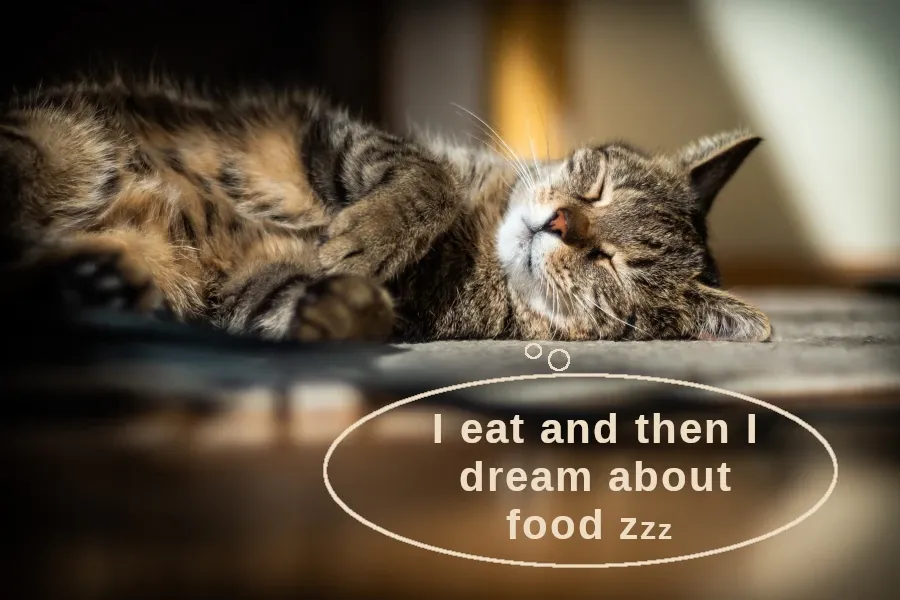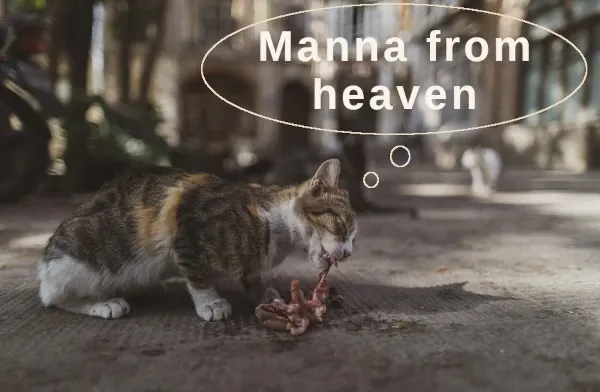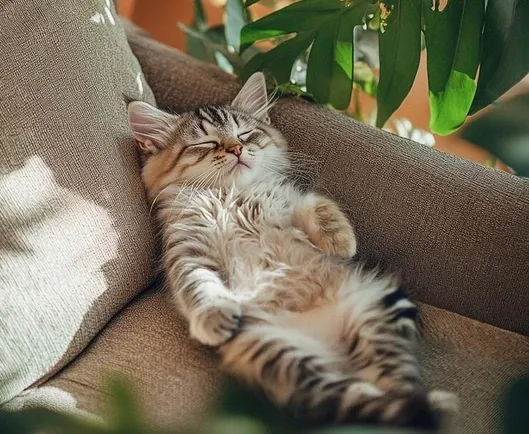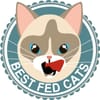The Far Less Considered Benefits Of Raw Feeding Cats
There are less considered but equally important gains for cats from eating a biologically appropriate, balanced raw food. This post looks at these less obvious, interesting and often surprising benefits.

The top, most obvious benefits of raw feeding were already covered in Part 1 and Part 2 of this discussion. But there are also other far less obvious benefits that are mostly overlooked.
The hidden benefits of raw feeding are often underestimated and discredited as anecdotal musings. But I bet they are pretty important to cats!
...most important food to a carnivore
A study of captive cheetah showed that those fed a diet of carcasses had noticeably improved appetites. They also had longer feeding times compared to their counterparts on the commercial diet 1.
The cats relished and enjoyed the carcasses noticeably more. They understandably showed greater possessiveness of this food and were willing to step up and defend it.
These cats obviously attached far greater value to their natural food to the point that they would risk injury to protect it.
...getting a food most worth having
Food is an important commodity to all animals. The cheetahs' motivation to hold on to the carcasses at all cost was likely from instinctively knowing that it was the most important food on offer.
A previous post discussed similar food selection in house cats where they placed the highest premium on nutritional value, despite how bad food tasted 2. This confirmed that, as carnivores, all cats value their instinctual food the highest.
Raw fed cats are essentially reverted back to a carnivore's highest reward food. What could be more satisfying than getting the food you value most?
...enhanced well-being
Raw feeding provides enrichment very few consider. Research clearly shows that captive exotic cats are behaviourally far more content and at ease on their instinctual food 3.
They showed a calmer demeanour and less stereotypical stress behaviours 1, 3. The carcass fed cats spent more time walking around and exploring as opposed to the aimless, compulsive pacing of their counterparts.
They also tended to lay down more after feeding, which signifies a more relaxed, restful state. The cats on the commercial foods did not express these behaviours to a noteworthy extent.
Natural feeding opportunities provide an important form of enrichment that leads to a more lasting contentedness and well-being in cats 4.

...increased dexterity
The natural feeding behaviours of cats are quite intricate. They first assess food for texture, firmness and the presence of bone. They dissect joints, crush bone as well as rip, tear and slice through meat with their carnassial teeth.
They also rapidly switch from vigorous chewing on one side of the mouth to the other. Plus they master correct prehension and gripping of food.
Cats on commercial foods rarely engage their carnassials or express these dexterous feeding behaviours.
...mental stimulation
Feeding behaviours have to be mastered for cats to be able to enjoy their ancestral food. This level of skill and coordination is simply not provided by the unnatural textures of commercial cat food.
The complexity, adroitness and coordination of deeply programmed behaviours offer mental stimulation that cats do not experience otherwise. Practice, precision and skill mastery keep a cat's senses keen and their faculties sharp.
Anyone who has seen a newcomer struggle with more challenging raw food items can attest to the amount of time they spend trying to figure things out. Raw feeders see first-hand how much learning is involved.
...enrichment and mastery
Any form of species-specific enrichment is a huge bonus in a cat's life. Such activities strongly correlate with increased physiological and psychological well-being 5, less behavioural problems 6 and enhanced quality of life.
Similarly, the psychological and mental benefits from skill-building activities are equally important. Learning the ropes of eating their natural food provides a fantastic skill-building opportunity and a way to express innate behaviours.
Cats are initially visibly baffled and unsure of how to approach this new food, but they quickly transform into surefooted carnivores. When they master feeding behaviours, cats become confident in their new-found skills.
Proficient, skillful feeding and food manipulation are a delight to watch. Many raw feeders beam with pride when they witness the change in their cats. Providing natural feeding opportunities reignite so much of what a cat inherently is.
...endorphine tide
Dr Anuschka Viljoen points out that natural feeding – prehension, gnawing and crushing bone – elicits an endorphin tide. This creates a satisfied, almost euphoric state in carnivores 7.
The endorphin rush provides post feeding satisfaction and a state of restfulness. This rush of peptides is often referred to as 'rest and digest', which is important for optimal digestion and food assimilation.
Cats that snack on kibble all day do not enter this restful digestive state. Instead, they experience lethargy and energy draining blood-sugar swings from high carbohydrates and sugars in these foods, which is not nearly the same as restful post feeding euphoria.

...post feeding euphoria
Dr Tom Lonsdale has long been referring to restful post feeding euphoria as the 'primitive feeding response' in carnivores 8. Experts agree that innate feeding behaviours have definite mood enhancing effects 3, 7, 9, 10.
The primal endorphine tide triggered by prehension and gnawing has a strong positive bearing on carnivore well-being 3 and immune competency 8. And these instinctive feeding behaviours form such a large part of natural feline traits.
Providing foods that elicit prehension and gnawing provide far greater enrichment, enjoyment and fulfillment than mindlessly gulping down kibble and soft canned foods.
...healthy microflora colonies
Gut flora adjustments on a biologically appropriate diet is the first stage of healing and restoration of balance 11.
It is well recognised that fermentation patterns and correct balance of intestinal microbiota are crucial and impact virtually every other facet of health 12.
In addition to optimal digestion and absorption, certain microflora in the gut has protective, anti-infective and biotherapeutic functioning 13. Biologically inappropriate foods disturb this synergy and wipe out beneficial strains in favour of bad bacteria.
Healthy cats on a natural diet have a well developed, very active gut microbiome 12. Only a natural diet can restore this high level of activity and balance.
...nose-friendly outcome
Commercial foods are completely wrong for a cat's biology. Large volumes of fillers and inappropriate ingredients produce a food that is not optimally assimilated. This creates a high percentage of waste.
The low digestibility, low absorbability and high waste properties of commercial diets 14 cause microbiome imbalance and bad bacteria overgrowth. These lead to painful bloating and abnormally foul, large, aerated stools we see in cats on these foods.
A raw diet is the opposite. It is a highly digestible, optimally absorbed and low waste food. On a raw diet, stools become firm, well formed, significantly smaller and much less odorous 14, 15. Now, who doesn't want that!?


Disclaimer
The information provided on the Bestfedcats.com website is educational and informational. We are here to give guidance on how to feed a properly balanced raw diet. We also offer advice on how to improve the diet of the modern house cat. Please note that we are not veterinarians. We are not here to give veterinary advice. Best Fed Cats will not be held responsible for any adverse reactions to your cat based on the information on our website. The health of your cat depends entirely on you. We expect you to use your knowledge of your cats, their circumstances and their health – in conjunction with a trusted veterinarian – to determine if any advice provided on this site is appropriate for your cats.

References
1 Bond, J. C., & Lindburg, D. G. (1990). Carcass feeding of captive cheetahs (Acinonyx jubatus): The effects of a naturalistic feeding program on oral health and psychological well-being. Applied Animal Behaviour Science, 26(4), 373–382.
2 Hewson-Hughes, A.K., V.L., Colyer, A., Simpson, S.J. & Raubenheimer, D. (2016). Balancing macronutrient intake in a mammalian carnivore: disentangling the influences of flavour and nutrition. Royal Society Open Science, 3, 1 – 12.
3 Malik, R. (2007). Feeding cats for health and longevity – an idiosyncratic perspective. Paper presented at the Small Animal Medicine Chapter Meeting, Australian College of Veterinary Scientists' Science Week.
4 The Little Carnivore (2021). Benefits of raw feeding: The science. Retrieved May 07, 2025, from https://thelittlecarnivore.com/en/blog/benefits-raw-feeding-cats-the-science/#source2=
5 Ruskell, A.D., Meiers, S.T., Jenkins, S.E. & Santymire, R.M. (2015). Effect of bungee-carcass enrichment on behavior and fecal glucocorticoid metabolites in two species of zoo-housed felids. Zoo Biology, 34(2), 170 – 177.
6 Ellis, S. (2007). Environmental enrichment for the domestic cat – an introduction. Veterinary Nursing Journal, 22(12), 19 – 23.
*7 Viljoen, A. (n.d.). Raw bones. In Simply Pets. Retrieved May 17, 2017, from http://www.simplypets.co.za/raw-feeding/raw-bones
8 Lonsdale, T. (1993). Preventative Dentistry. Veterinary Dentistry Proceedings 212, New South Wales, Australia.
9 Zurich, L. (2010). Raw fed cats: Feeding cats a diet of whole raw foods based on nature's model, an illustrated companion guide. [Ebook]. USA: Self-Published
10 Dion, T. (2012). Dem bones, dem bones, dem... scary bones. In Cat Centric. Retrieved May 09, 2025, from http://catcentric.org/nutrition-and-food/raw-feeding/dem-bones-dem-bones-dem-scary-bones/
11 Innocent, M. (2017). Naturally healthy cats: Complete health for your cat (3rd ed). [Ebook]. Perth, Australia: Self-Published.
12 Depauw, S., Hesta, M., Whitehouse-Tedd, K., Vanhaecke, L., Verbrugghe, A. & Janssens, G.P.J. (2013). Animal fibre: The forgotten nutrient in strict carnivores? First insights in the cheetah. Journal of Animal Physiology and Animal Nutrition, 97(1), 146 – 154.
13 Liévin-Le Moal, V. & Servin, A.L. (2014). Anti-Infective activities of Lactobacillus strains in the human Intestinal microbiota: From probiotics to gastrointestinal anti-infectious biotherapeutic agents. Clinical Microbiology Reviews, 27(2), 167 – 199.
14 Pierson, L.A. (n.d.). Feeding your cat: Know the basics of feline nutrition. In Cat Info. Retrieved May 09, 2025, from http://catinfo.org
15 Feline Future (n.d.). Constipation. Retrieved May 09, 2025, from https://tcfeline.com/constipation/
* Resource no longer available online. It is nonetheless cited as it contains valuable, original information from an important author.
